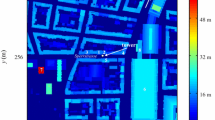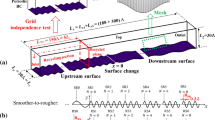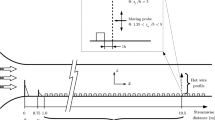Abstract
Dynamics in the roughness (RSLs) and inertial (ISLs) sublayers in the turbulent boundary layers (TBLs) over idealised urban surfaces are investigated analytically and experimentally. In this paper, we derive an analytical solution to the mean velocity profile, which is a continuous function applicable to both RSL and ISL, over rough surfaces in isothermal conditions. Afterwards, a modified mixing-length model for RSL/ISL transport is developed that elucidates how surface roughness affects the turbulence motions. A series of wind tunnel experiments are conducted to measure the vertical profiles of mean and fluctuating velocities, together with momentum flux over various configurations of surface-mounted ribs in cross flows using hot-wire anemometry (HWA). The analytical solution agrees well with the wind tunnel result that improves the estimate to mean velocity profile over urban surfaces and TBL dynamics as well. The thicknesses of RSL and ISL are calculated by monitoring the convergence/divergence between the temporally averaged and spatio-temporally averaged profiles of momentum flux. It is found that the height of RSL/ISL interface is a function of surface roughness. Examining the direct, physical influence of roughness elements on near-surface RSL flows reveals that the TBL flows over rough surfaces exhibit turbulence motions of two different length scales which are functions of the RSL and ISL structure. Conclusively, given a TBL, the rougher the surface, the higher is the RSL intruding upward that would thinner the ISL up to 50 %. Therefore, the conventional ISL log-law approximation to TBL flows over urban surfaces should be applied with caution.










Similar content being viewed by others
References
Abramowitz M, Stegun IA (1964) Handbook of mathematical functions: with formulas, graphs, and mathematical tables. Dover Publications, Inc., New York
Arya PS (2001) Introduction to micrometeorology. Academic Press, San Diego
Baetke F, Werner H, Wengle H (1990) Numerical simulation of turbulent flow over surface-mounted obstacles with sharp edges and corners. J Wind Eng Ind Aerodyn 35:129–147
Batchvarova E, Gryning SE (2006) Progress in urban dispersion studies. Theor Appl Climatol 84:57–67
Belcher S, Jerram N, Hunt J (2003) Adjustment of a turbulent boundary layer to a canopy of roughness elements. J Fluid Mech 488:369–398
Böhm M, Finnigan JJ, Raupach MR, Hughes D (2013) Turbulence structure within and above a canopy of bluff elements. Bound-Lay Meteorol 146:393–419
Bruun H (1971) Interpretation of a hot wire signal using a universal calibration law. J Phys E Sci Instrum 4:225
Castro IP, Robins AG (1977) The flow around a surface-mounted cube in uniform and turbulent streams. J Fluid Mech 79:307–335
Castro IP, Cheng H, Reynolds R (2006) Turbulence over urban-type roughness: deductions from wind-tunnel measurements. Bound-Lay Meteorol 118:109–131
Cellier P, Brunet Y (1992) Flux-gradient relationships above tall plant canopies. Agric For Meteorol 58:93–117
Cheng H, Castro IP (2002a) Near-wall flow development after a step change in surface roughness. Bound-Lay Meteorol 105:411–432
Cheng H, Castro IP (2002b) Near wall flow over urban-like roughness. Bound-Lay Meteorol 104:229–259
Cheng WC, Liu C-H (2011) Large-eddy simulation of flow and pollutant transports in and above two-dimensional idealized street canyons. Bound-Lay Meteorol 139:411–437
Cheng H, Hayden P, Robins AG, Castro IP (2007) Flow over cube arrays of different packing densities. J Wind Eng Ind Aerodyn 95:715–740
Cionco RM (1965) A mathematical model for air flow in a vegetative canopy. J Appl Meteorol 4:517–522
Coceal O, Belcher S (2004) A canopy model of mean winds through urban areas. Q J Roy Meteorol Soc 130:1349–1372
Coceal O, Belcher S (2005) Mean winds through an inhomogeneous urban canopy. Bound-Lay Meteorol 115:47–68
Cook N (1973) On simulating the lower third of the urban adiabatic boundary layer in a wind tunnel. Atmos Environ 7:691–705
Counihan J (1975) Adiabatic atmospheric boundary layers: a review and analysis of data from the period 1880–1972. Atmos Environ 9:871–905
De Ridder K (2010) Bulk transfer relations for the roughness sublayer. Bound-Lay Meteorol 134:257–267
Drobinski P, Carlotti P, Redelsperger J-L, Masson V, Banta RM, Newsom RK (2007) Numerical and experimental investigation of the neutral atmospheric surface layer. J Atmos Sci 64:137–156
Fackrell J, Robins A (1982) Concentration fluctuations and fluxes in plumes from point sources in a turbulent boundary layer. J Fluid Mech 117:1–26
Finnigan J (2000) Turbulence in plant canopies. Annu Rev Fluid Mech 32:519–571
Flack KA, Schultz MP, Shapiro TA (2005) Experimental support for Townsend’s Reynolds number similarity hypothesis on rough walls. Phys Fluids 17:035102
Florens E, Eiff O, Moulin F (2013) Defining the roughness sublayer and its turbulence statistics. Experiments in Fluids 54:1–15
Foken T (2008) Micrometeorology. Springer-Verlag, Berlin Heidelberg
Garratt J (1978) Flux profile relations above tall vegetation. Q J Roy Meteorol Soc 104:199–211
Garratt JR (1994) The atmospheric boundary layer. Cambridge University Press, Cambridge
Graefe J (2004) Roughness layer corrections with emphasis on SVAT model applications. Agrical Forest Meteorol 124:237–251
Grimmond CSB (2006) Progress in measuring and observing the urban atmosphere. Theor Appl Climatol 84:3–22
Hanna SR, Britter RE (2010) Wind flow and vapor cloud dispersion at industrial and urban sites. Wiley, Hoboken
Harman IN, Finnigan JJ (2007) A simple unified theory for flow in the canopy and roughness sublayer. Bound-Lay Meteorol 123:339–363
Jackson P (1981) On the displacement height in the logarithmic velocity profile. J Fluid Mech 111:15–25
Jimenez J (2004) Turbulent flows over rough walls. Annu Rev Fluid Mech 36:173–196
Jiménez J, Moin P (1991) The minimal flow unit in near-wall turbulence. J Fluid Mech 225:213–240
Kaimal JC, Finnigan JJ (1994) Atmospheric boundary layer flows: their structure and measurement. Oxford University Press, Inc., New York
Kanda M (2006) Progress in the scale modeling of urban climate: review. Theor Appl Climatol 84:23–33
Kanda M, Moriwaki R, Kasamatsu F (2004) Large-eddy simulation of turbulent organized structures within and above explicitly resolved cube arrays. Bound-Lay Meteorol 112:343–368
Kastner-Klein P, Rotach MW (2004) Mean flow and turbulence characteristics in an urban roughness sublayer. Bound-Lay Meteorol 111:55–84
Kozmar H (2010) Scale effects in wind tunnel modelling of an urban atmospheric boundary layer. Theor Appl Climatol 100:153–162
Kozmar H (2011) Characteristics of natural wind simulations in the TUM boundary layer wind tunnel. Theor Appl Climatol 106:95–104
Krogstad P-Å, Antonia R, Browne L (1992) Comparison between rough-and smooth-wall turbulent boundary layers. J Fluid Mech 245:599–617
Liu C-H, Ng C-T, Wong CC (2015) A theory of ventilation estimate over hypothetical urban areas. J Hazard Mater 296:9–16
Macdonald R (2000) Modelling the mean velocity profile in the urban canopy layer. Bound-Lay Meteorol 97:25–45
Macdonald R, Schofield SC, Slawson P (2002) Physical modelling of urban roughness using arrays of regular roughness elements. Water Air Soil Pollut Focus 2:541–554
Mohammad AF, Zaki SA, Hagishima A, Ali MSM (2015) Determination of aerodynamic parameters of urban surfaces: methods and results revisited. Theor Appl Climatol 122:635–649
Mölder M, Grelle A, Lindroth A, Halldin S (1999) Flux-profile relationships over a boreal forest - roughness sublayer corrections. Agric For Meteorol 98:645–658
Moriwaki R, Kanda M (2006) Flux-gradient profiles for momentum and heat over an urban surface. Theor Appl Climatol 84:127–135
Nicolini G, Fratini G, Avilov V, Kurbatova J, Vasenev I, Valentini R (2015) Performance of eddy-covariance measurements in fetch-limited applications. Theor Appl Climatol 1-12. doi:10.1007/s00704-015-1673-x
Oke TR (2002) Boundary layer climates. Routledge, New York
Panofsky HA, Dutton JA (1984) Atmospheric turbulence: models and methods for engineering applications. Wiley, Hoboken
Perry AE, Lim KL, Henbest SM (1987) An experimental study of the turbulence structure in smooth- and rough-wall boundary layers. J Fluid Mech 177:437–466
Poggi D, Porporato A, Ridolfi L, Albertson J, Katul G (2004) The effect of vegetation density on canopy sub-layer turbulence. Bound-Lay Meteorol 111:565–587
Pokrajac D, Campbell LJ, Nikora V, Manes C, McEwan I (2007) Quadrant analysis of persistent spatial velocity perturbations over square-bar roughness. Experiments in Fluids 42:413–423
Pope SB (2000) Turbulent flows. Cambridge University Press, Cambridge
Raupach MR (1992) Drag and drag partition on rough surfaces. Bound-Lay Meteorol 60:375–395
Raupach M, Thom A, Edwards I (1980) A wind-tunnel study of turbulent flow close to regularly arrayed rough surfaces. Bound-Lay Meteorol 18:373–397
Raupach M, Coppin P, Legg B (1986) Experiments on scalar dispersion within a model plant canopy, part I: the turbulence structure. Bound-Lay Meteorol 35:21–52
Raupach M, Antonia R, Rajagopalan S (1991) Rough-wall turbulent boundary layers. Appl Mech Rev 44:1–25
Raupach MR, Finnigan J, Brunei Y (1996) Coherent eddies and turbulence in vegetation canopies: the mixing-layer analogy. Bound-Lay Meteorol 78:351–382
Raupach MR, Hughes DE, Cleugh HA (2006) Momentum absorption in rough-wall boundary layers with sparse roughness elements in random and clustered distributions. Bound-Lay Meteorol 120:201–218
Robins A (1979) The development and structure of simulated neutrally stable atmospheric boundary layers. J Ind Aerod Wind Eng 4:71–100
Robins A (2003) Wind tunnel dispersion modelling some recent and not so recent achievements. J Wind Eng Ind Aerod 91:1777–1790
Rotach MW (1999) On the influence of the urban roughness sublayer on turbulence and dispersion. Atmos Environ 33:4001–4008
Roth M (2000) Review of atmospheric turbulence over cities. Q J Roy Meteorol Soc 126:941–990
Salizzoni P, Soulhac L, Mejean P, Perkins RJ (2008) Influence of a two-scale surface roughness on a neutral turbulent boundary layer. Bound-Lay Meteorol 127:97–110
Shuttleworth WJ (1989) Micrometeorology of temperate and tropical forest. Phil Trans R Soc London B 324:299–334
Snyder WH, Castro IP (2002) The critical Reynolds number for rough-wall boundary layers. J Wind Eng Ind Aerod 90:41–54
Stull RB (1988) An introduction to boundary layer meteorology. Springer, Netherlands
Tennekes H, Lumley JL (1972) A first course in turbulence. MIT press, USA
Tomas S, Eiff O, Masson V (2011) Experimental investigation of turbulent momentum transfer in a neutral boundary layer over a rough surface. Bound-Lay Meteorol 138:385–411
Townsend AA (1980) The structure of turbulent shear flow. Cambridge University Press, Cambridge
Uehara K, Murakami S, Oikawa S, Wakamatsu S (2000) Wind tunnel experiments on how thermal stratification affects flow in and above urban street canyons. Atmos Environ 34:1553–1562
Verhoef A, McNaughton KG, Jacobs AFG (1997) A parameterization of momentum roughness length and displacement height for a wide range of canopy densities. Hydrol Earth Syst Sci 1:81–91
Xie Z, Voke PR, Hayden P, Robins AG (2004) Large-eddy simulation of turbulent flow over a rough surface. Bound-Lay Meteorol 111:417–440
Yumao X, Chaofu Z, Zhongkai L, Wei Z (1997) Turbulent structure and local similarity in the tower layer over the Nanjing area. Bound-Lay Meteorol 82:1–21
Acknowledgement
The first author wishes to thank the Hong Kong Research Grants Council (RGC) for financially supporting his study through the Hong Kong PhD Fellowship (HKPF) scheme. This project is partly supported by the General Research Fund (GRF) of RGC HKU 714913E. Technical support from Mr. Vincent KW Lo is appreciated.
Author information
Authors and Affiliations
Corresponding author
Additional information
Revised manuscript submitted to Theoretical and Applied Climatology on 17 June 2016
Rights and permissions
About this article
Cite this article
Ho, YK., Liu, CH. A wind tunnel study of flows over idealised urban surfaces with roughness sublayer corrections. Theor Appl Climatol 130, 305–320 (2017). https://doi.org/10.1007/s00704-016-1877-8
Received:
Accepted:
Published:
Issue Date:
DOI: https://doi.org/10.1007/s00704-016-1877-8




